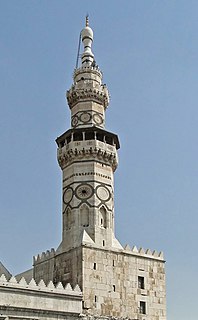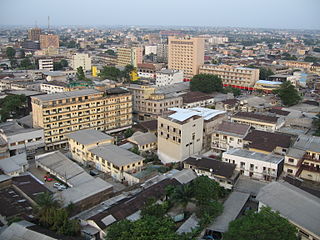Related Research Articles

Cameroon, officially the Republic of Cameroon, is a country in west-central Africa. It is bordered by Nigeria to the west and north; Chad to the northeast; the Central African Republic to the east; and Equatorial Guinea, Gabon and the Republic of the Congo to the south. Its coastline lies on the Bight of Biafra, part of the Gulf of Guinea and the Atlantic Ocean. The country is sometimes identified as West African and other times as Central African, due to its strategic position at the crossroads between West and Central Africa. Its nearly 25 million people speak 250 native languages.

A minaret is a type of tower typically built into or adjacent to mosques. Minarets are generally used to project the Muslim call to prayer (adhan), but they also served as landmarks and symbols of Islam's presence. They can have a variety of forms, from thick, squat towers to soaring, pencil-thin spires.

British Cameroon or British Cameroons was a British mandate territory in British West Africa, formed of Northern Cameroons and Southern Cameroons. Today, Northern Cameroons forms parts of the Borno, Adamawa, and Taraba states of Nigeria, and Southern Cameroons is a part of Cameroon.

Kamerun was an African colony of the German Empire from 1884 to 1916 in the region of today's Republic of Cameroon. Kamerun also included northern parts of Gabon and the Congo with western parts of the Central African Republic, southwestern parts of Chad and far eastern parts of Nigeria.

Ambazonia, officially the Federal Republic of Ambazonia, also referred to as Amba Land, is an unrecognised breakaway state in West Africa constituting the Northwest Region and Southwest Region of Cameroon, part of the British mandate territory historically known as the Southern Cameroons. No country has formally recognized Ambazonia's independence, and it is currently the site of an armed conflict between Ambazonian separatists and the Cameroonian military known as the Anglophone Crisis. Ambazonia is located in the west of Cameroon and southeast of Nigeria on the Gulf of Guinea.

Tiv are a Tivoid ethnic group. They constitute approximately 2.4% of Nigeria's total population, and number over 5 million individuals throughout Nigeria and Cameroon. The Tiv language is spoken by about 5 million people in Nigeria with a few speakers in Cameroon. Most of the language's Nigerian speakers are found in Benue, Taraba, Nasarawa and Plateau States. The language is a branch of Benue–Congo and ultimately of the Niger–Congo phylum. In pre-colonial times, the Fulani ethnic group referred to the Tiv as "Munchi", a term not accepted by Tiv people. They depend on agricultural produce for commerce and life.

Cameroonian cuisine is one of the most varied in Africa due to Cameroon's location on the crossroads between the north, west, and center of the continent; the diversity in ethnicity with mixture ranging from Bantus, Semi-bantus and Shuwa Arabs, as well as the influence of German, French and English colonialization.

Sir David Frank Adjaye is a Ghanaian-British architect. He is known for having designed many notable buildings around the world, including the National Museum of African American History and Culture in Washington, D.C. Adjaye was knighted in the 2017 New Year Honours for services to architecture. He is the recipient of the 2021 Royal Gold Medal, making him the first African recipient and one of the youngest recipients.

King Ibrahim Mbouombouo Njoyac. 1860 – c. 1933 in Yaoundé, was seventeenth in a long dynasty of kings that ruled over Bamum and its people in western Cameroon dating back to the fourteenth century. He succeeded his father Nsangu, and ruled from 1886 or 1887 until his death in 1933, when he was succeeded by his son, Seidou Njimoluh Njoya. He ruled from the ancient walled city of Fumban.

Douala is the largest city in Cameroon and its economic capital. It is also the capital of Cameroon's Littoral Region. Home to Central Africa's largest port and its major international airport, Douala International Airport (DLA), it is the commercial and economic capital of Cameroon and the entire CEMAC region comprising Gabon, Congo, Chad, Equatorial Guinea, Central African Republic and Cameroon. Consequently, it handles most of the country's major exports, such as oil, cocoa and coffee, timber, metals and fruits. As of 2015, the city and its surrounding area had an estimated population of 2,768,400. The city sits on the estuary of Wouri River and its climate is tropical.

The horseshoe arch, also called the "Moorish arch" and the "keyhole arch", is the emblematic arch of Islamic architecture, especially Moorish architecture. Horseshoe arches can take rounded, pointed or lobed form.

Warren Murray Robbins was an American art collector, whose collection of African art led to the formation of the National Museum of African Art at the Smithsonian Institution.

Belo is a town and commune in Northwest Region of Cameroon. It is mainly populated by Kom people.
Fundong is a town and commune in Cameroon. It is the capital of Boyo Division, with a population of about 20,000. It is situated about 80 km from Bamenda, the regional Headquarters of the North West region. The population of Fundong is mostly rural with farming as primary occupation.
The following is a timeline of the history of the city of Douala, Cameroon.
The following is a timeline of the history of Zanzibar City, Unguja island, Zanzibar, Tanzania. The city is composed of Ng'ambo and Stone Town. Until recently it was known as Zanzibar Town.
The Afo-A-Kom is a wooden sculpture, the foremost symbol of the Kom people of the North West Region of Cameroon. In 1966 it was stolen from Kom's royal compound. Seven years later it was recognized in a U.S. art gallery, and after some dispute, it was returned to the Kom people.

Howard Crosby Butler was an American archaeologist. Butler graduated from Princeton University, and later pursued special studies at the Columbia School of Architecture and at the American School of Classical Studies in Rome and in Athens. In 1899, 1904, and 1909, he was at the head of archaeological expeditions in Syria. Turkey's unsolicited request that he oversee the excavation of Sardis represented a rare distinction for an American and a Christian. He became professor of the history of architecture at Princeton in 1905. Butler became unwell on August 11, 1922 after returning from Sardis, via Naples. He was admitted to the American Hospital of Paris in Neuilly on August 13 and died that night.
The following is a timeline of the history of the city of Yaoundé, Cameroon.
Susan Mullin Vogel is a curator, professor, scholar, and filmmaker whose area of focus is African art. She was a curator at the Metropolitan Museum of Art, founded what is now The Africa Center in the early 1980s, served as Director of the Yale University Art Gallery, taught African art and architecture at Columbia University, and has made films.
References
- ↑ "Cameroon: Laikom - the Bedrock of Kom Culture - allAfrica.com". Archived from the original on 2018-01-31.
- ↑ Times, Sandra Blakeslee Special to The New York (December 14, 1973). "Fons' Power Died in Last 20 Years and With It, Much Respect". The New York Times.
- ↑ Vries, Jacqueline de (March 17, 2020). "The Leopard that Came to Laikom: Michael Timneng in Colonial Cameroon". The Individual in African History. Brill. pp. 148–169. doi:10.1163/9789004407824_007. ISBN 9789004407824. S2CID 216187245 – via brill.com.
- ↑ SHANKLIN, EUGENIA (1985). "The Path to Laikom: Kom Royal Court Architecture". Paideuma. 31: 111–150. JSTOR 23076458 – via JSTOR.
- ↑ https://www.metmuseum.org/art/collection/search/320956 [ bare URL ]
Coordinates: 6°15′N10°20′E / 6.250°N 10.333°E